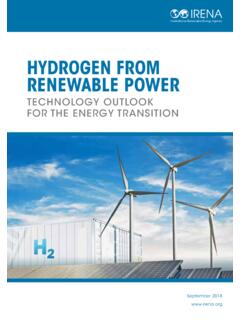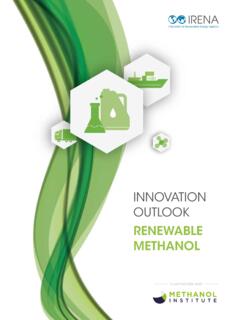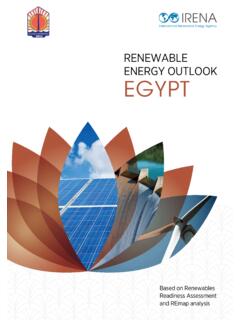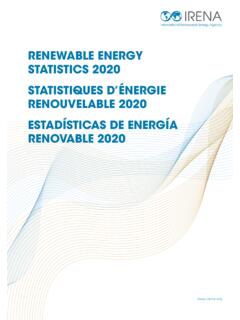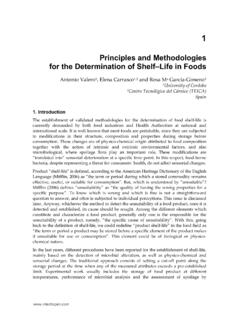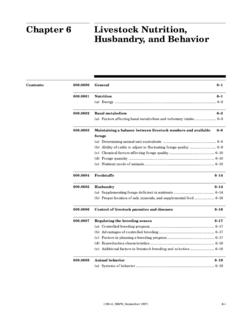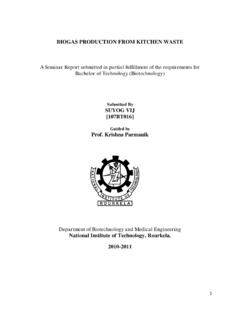Transcription of Measuring Small-scale Biogas Capacity and Production
1 Measuring Small-scale Biogas Capacity and Production Copyright IRENA 2016 Unless otherwise stated, this publication and material featured herein are the property of the International Renewable Energy Agency (IRENA) and are subject to copyright by IRENA. Material in this publication may be freely used, shared, copied, reproduced, printed and/or stored, provided that all such material is clearly attributed to IRENA and bears a notation that it is subject to copyright ( IRENA), with the year of the copyright. Material contained in this publication attributed to third parties may be subject to third party copyright and separate terms of use and restrictions, including restrictions in relation to any commercial use.
2 ISBN 978-92-95111-12-7 (PDF) This report should be cited: IRENA (2016), Measuring Small-scale Biogas Capacity and Production , International Renewable Energy Agency (IRENA), Abu Dhabi About IRENA The International Renewable Energy Agency (IRENA) is an intergovernmental organisation that supports countries in their transition to a sustainable energy future, and serves as the principal platform for international co-operation, a centre of excellence, and a repository of policy, technology, resource and financial knowledge on renewable energy. IRENA promotes the widespread adoption and sustainable use of all forms of renewable energy, including bioenergy, geothermal, hydropower, ocean, solar and wind energy, in the pursuit of sustainable development, energy access, energy security and low-carbon economic growth and prosperity.
3 Prepared by Samah Elsayed, IRENA Programme Officer, Capacity Building in Statistics For further information or to provide feedback, please contact the IRENA statistics team This report is available for download: . Disclaimer This publication and the material featured herein are provided as is , for informational purposes. All reasonable precautions have been taken by IRENA to verify the reliability of the material featured in this publication. Neither IRENA nor any of its officials, agents, data or other third-party content providers or licensors provides any warranty, including as to the accuracy, completeness, or fitness for a particular purpose or use of such material, or regarding the non-infringement of third-party rights, and they accept no responsibility or liability with regard to the use of this publication and the material featured therein.
4 The information contained herein does not necessarily represent the views of the Members of IRENA, nor is it an endorsement of any project, product or service provider. The designations employed and the presentation of material herein do not imply the expression of any opinion on the part of IRENA concerning the legal status of any region, country, territory, city or area or of its authorities, or concerning the delimitation of frontiers or boundaries. CONTENTS 1. INTRODUCTION .. 1 What is a Biogas digester? .. 1 Why are Biogas statistics collected? .. 1 Guidance structure .. 2 2. THE MAIN PARAMETERS AFFECTING Biogas Production .
5 3 Digester technologies .. 3 Plant Capacity .. 4 Total feedstock volume .. 4 Feedstock properties .. 5 Feedstock retention time .. 5 Temperature .. 5 3. PLANT Capacity .. 6 Administrative data .. 6 Survey of standardised Biogas plant types .. 7 Survey of Biogas plant dimensions .. 7 4. Biogas Production AND CONSUMPTION .. 12 Plant Capacity .. 13 Appliance use .. 13 Feedstock use .. 15 Fuel substitution .. 18 Direct measurement .. 19 5. OTHER INFORMATION ABOUT Biogas Production .. 20 Financial and technical performance .. 20 Emissions 21 Energy access and socioeconomic impacts .. 21 REFERENCES .. 23 APPENDIX 1: Biogas PLANT CALCULATION TABLES.
6 25 APPENDIX 2: Biogas DATA COLLECTION IN CHINA .. 29 Rural renewable energy statistics system .. 29 Green county monitoring system .. 30 1 1. INTRODUCTION Interest in Small-scale Biogas technologies has increased in recent years across Africa, Asia and Latin America. This has been driven by the socio-economic and environmental benefits of using Biogas , such as reduced firewood and kerosene consumption, lower emissions of greenhouse gases and indoor air pollutants and the possibilities to use Biogas to treat human and animal wastes (Bunny & Besselink, 2006). Given this trend, Biogas use needs to be accurately monitored and measured.
7 This guide aims to help energy statisticians to measure and estimate the Capacity and Production of Biogas plants, as well as other aspects of Biogas Production . The main focus is on data collection from Small-scale household, communal or farm Biogas plants that produce Biogas in a continuous process ( feedstocks are added and Biogas removed every day). The methods described here may also be used for large-scale Biogas plants or plants producing electricity, but such facilities should have monitoring devices to measure Production more easily and accurately. WHAT IS A Biogas DIGESTER?
8 The main part of a Biogas plant is the digester, which is an airtight container in which bacteria break down organic waste through a process of anaerobic This generates a gas ( Biogas ) that is mostly methane and carbon dioxide (CO2). This gas can be used for cooking, heating and lighting, or it can be used to generate electricity. As more material is added to the digester, a liquid waste (slurry) is also produced, which can be used as a fertiliser. Biogas digesters can vary greatly in Capacity , ranging from Small-scale units used by households to larger communal and industrial digesters.
9 Feedstocks added to the digester can include many types of biomass such as animal, food and agricultural waste, but materials that are difficult for the bacteria to digest ( wood) should be avoided. The amount of Biogas produced depends on a range of factors including the type and amount of biomass used, the digester size and temperature. WHY ARE Biogas STATISTICS COLLECTED? The amount and type of Biogas data collected will depend on how this information will be used. For example, project and policy monitoring may require the collection of specific and detailed data, while 1 Anaerobic fermentation means that the fermentation or digestion occurs in the absence of oxygen.
10 Monitoring of renewable energy targets may only need very basic data that can be obtained from a few Biogas questions in a census or household survey. The following are some examples of how Biogas statistics may be used and the sorts of data that might be needed. National energy statistics In some countries, Biogas contributes significantly to the national energy balance. It may be used both as a fuel and to generate electricity. To produce these statistics, Biogas data collection should focus on plant Capacity and Production of Biogas and electricity. Project and policy monitoring More detailed Biogas statistics may be required to monitor implementation of Biogas projects, programmes and policies.


